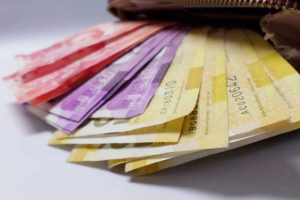P57.43/$: Where do we go from this record low?

On Sept. 15, 2022, the peso-dollar exchange rate reached a milestone at P57.43/$, a record low in our history. While worrying to many, this presents a challenge and an opportunity. The challenge is how to respond moving forward so that the adversity it has sown is turned into the seed of a better, more resilient future harvest. History has object lessons here.
In 2012, to keep the peso-dollar exchange rate from going below P40/$ due to heavy portfolio inflows thanks to the aggressive quantitative easing by the US Federal Reserve Board, the Bangko Sentral ng Pilipinas (BSP), then under Governor Amando Tetangco, Jr., waged a scorched-earth war against further peso appreciation. It switched to becoming a determined buyer of dollars, which resulted in the BSP’s Gross International Reserve (GIR) climbing to unprecedented heights (~$80-billion, at that time a record). The BSP effectively borrowed pesos from the public and the banks through the Special Deposit Account (SDA) where billions of banking sector resources were parked to soak up on hefty risk-free interest rate. This exceptionally high interest rate is contractionary and meant little lending to the private investing public and a consequent slowdown of the economy. The BSP could also have just printed pesos or reduced the banking reserve requirement which, however, would have risked inflation exceeding its self-imposed ceiling.
It was the correct policy move then since a further drop to P35/$ would have decimated the Manufacturing sector already emaciated by almost a decade-long appreciation of the peso from its low in 2004. But this determined defense of the peso sat uncomfortably with the BSP’s self-imposed inflation targeting, with the market being the ultimate arbiter of the exchange rate. The headline inflation target was between 3-5% in 2012-2024 (Tetangco, 2012, Inflation Report Q2 2012). The actual headline inflation was 3.3% in November 2013. There was no call for appreciation resistance from the inflation front! The BSP’s action, though correct, revealed a quirk in its inflation targeting commitment — it will go to war to defend a notional line of resistance on the exchange rate level.
This attitude echoes the Chinese central bank’s refusal to allow any but puny movements in the exchange rate in the first decades of this century. Because the ammunition for the defense of an undervalued currency is the domestic currency which it can easily print apart from some capital controls, this was easy.
Both the yuan case and the BSP 2012 cases revealed a line of resistance. The difference is where the line of resistance is drawn. The Chinese monetary authority’s line of resistance is drawn where a trade surplus becomes a permanent fixture of the Chinese economy; this means a manufacturing sector that outsells competitors at foreign outlets like Walmart or Sainsbury’s. The Philippine monetary authority’s line of resistance seems to be where the Philippine manufactures, or whatever is left of it, can barely hold their own in SM North or Robinson’s. And yet the line of resistance in the Philippines could have been drawn at P50/$; the Philippines peso-dollar exchange rate was already at P56.45/$ in October 2004. In other words, we already paid the inflationary price of the depreciation (inflation was 7.7% in 2005). It was a wasted crisis.
What the BSP did after 2004 was underwhelming if not out-rightly self-lacerating. Brandishing the well-worn excuse of a market-determined exchange rate, it allowed the peso to appreciate back to P40.67/$ by February 2013 from its 2004 low as portfolio investment flocked back when the US Federal Reserve walked back its quantitative easing. To the Chinese monetary authority, our excuse reads like surrendering to the US Federal Reserve Board and portfolio investors the prerogative of determining the domestic investment and poverty alleviation program! Investors in the Philippines and abroad, rightly seeing that 2004 peso/dollar level had no legs, rightly refused to shift investment towards tradables. Indeed, tradables suffered a hollowing out. Is it any wonder that the Philippines now imports everything?
What happened between 2004-2012 echoed the 41% interest rate on one year maturity treasury bill in 1984 (BSP’s Selected Domestic Interest Rates, http://www.bsp.gov.ph) and the central bank’s employment of JOBO bills with high interest rate to maintain a grossly misaligned peso value. The banks with ready cash became filthy rich while the Philippine economy shrunk and the Filipinos went hungry. No different from the use of high-interest SDAs to push the peso from P29.83/$ in September 1993 back to P23.87 in November 1994. That was when a group of then-young economists (Benjamin Diokno, Cayetano Paderanga, Emmanuel de Dios, Calixto Chikiamco, and this author) recommended that we devalue the peso to P35/$ to keep the People’s Republic of China (PRC), which had devalued the yuan 40%, from eating our lunch. This group was instead subjected to vicious attacks as “jukebox economists” (lackeys following International Monetary Fund-World Bank money). In truth, the recommendation went squarely against the IMF-WB. The latter was then bamboozling LDC central bankers into the “fear of fixing” with the gobbledygook of the impossible trinity favoring an open capital account and a flexible exchange rate. They, however, could not stampede PRC, and especially not Robert Mundell, co-author of the seminal paper on policy trilemma. He knew better and supported PRC’s heretical yuan policy. To the clamor by the private business for relief from killer high interest rates, the BSP responded with, “Let them borrow abroad!” The private sector, heeding the BSP advice, was thus led like lambs into the slaughter of the 1998 Asian Financial Crisis! And President Fidel Ramos’ highly touted tiger cub economy became the collateral damage!
WHAT WE COULD DO: FLEXRDNow that we are at P57.43/$, we can do either of two things: repeat the mistakes of the past — surrender the fate of our investment and poverty-reduction programs to the US Federal Reserve and the global portfolio forces — that means the exchange rate will be pushed back to P48/$ or thereabouts, or we can seize the opportunity in this crisis to shift to an economic regime where we determine our own investment and poverty reduction future.
This we do by adopting a regime of a flexible exchange rate with a ratchet downward (FLEXRD) with the following features: (i) sway with an externally induced pressure for a depreciation (don’t waste precious forex reserve resisting such pressure which the BSP wisely did in early 2022), (ii) lean against an externally induced pressure for appreciation (as the BSP did in 2012, as Vietnam did in 2020, and as PRC still does), and, (iii) adopt (ii) when the wind reverses from a depreciation to appreciation pressure. This implies choosing a line of resistance that opens the door for a permanent trade surplus.
Historians Will and Ariel Durant observed in their monumental 11 volume opus (The Story of Civilization) that “History teaches but man never learns!” Fortunately, history is not destiny! Although our own policy history suggests our response will again reprise past mistakes, proving the Durants right again, the opportunity and the challenge before our economic authorities today is for once to prove the Durants wrong.
Raul V. Fabella is a retired professor of the UP School of Economics, a member of the National Academy of Science and Technology and an honorary professor of the Asian Institute of Management. He gets his dopamine fix from bicycling and tending flowers with wife Teena.




